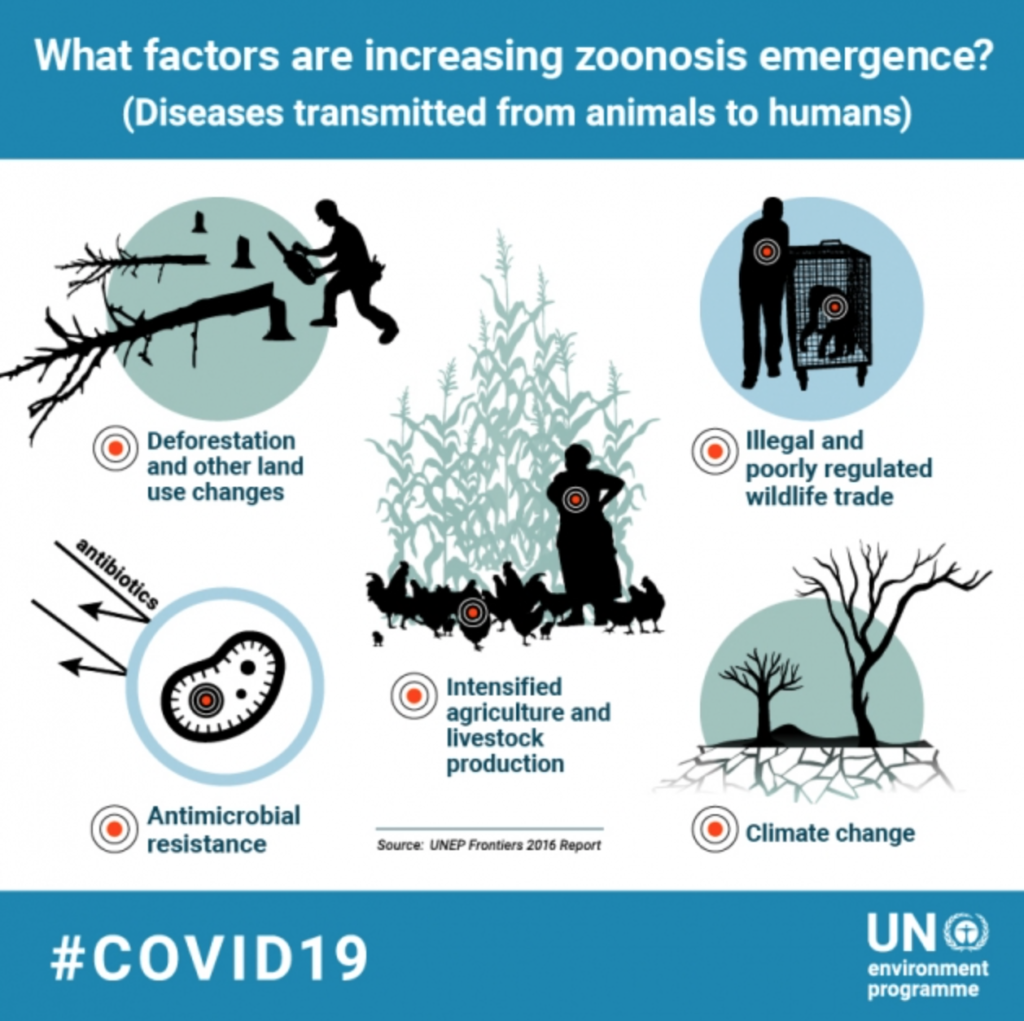Zoonotic diseases are the result of the transfer of infectious pathogens from animals to humans. Agriculture impacts this process tremendously. At first glance, you might ask how are these two things even related? Zoonotic events are becoming increasingly common, in part due to agricultural land-use changes where forests are cut down and land is converted for agricultural use to accommodate the rise in industrial and commercial farming.
Livestock (pigs, chickens, and cows) can serve as the perfect intermediate host for a zoonotic disease where a pathogen is spread from a wild animal to the livestock and then to humans. A study completed by Bloomfield et al. (2020) found that Ugandan farmers who resided near forests had a higher chance of zoonosis spillover between wild primates and humans due to the proximity of the forests and farmer’s land. The farmers would utilize the forests for wood, putting them in closer contact with the wild animals, while the primates would crop-raid searching the harvest for food putting them in closer contact with the farmers. To minimize this contact, it has been suggested that tree farms or reforestation initiatives are introduced to act as a ‘buffer zone’ between the forests and the farms.
Infectious diseases also thrive under industrial farming practices. Mourkas et al. (2020) found that crowding animals and overusing antibiotics led to greater chances of harmful pathogens passing from livestock to humans. Large, confined clusters of animals can also cause stress to the livestock, increasing the susceptibility for pathogens to jump to humans. Widespread and consistent antibiotic use allows for bacteria to create more resistant strains. Intermediate reservoirs like livestock also allow for specific pathogens to mutate and modify before being passed to humans. This aids the virus in becoming more successful at infection and transmission before they even enter the human body.

Ironically, humans are creating the perfect zones for zoonoses spillover and transmission. Approximately 90% of the global meat supply is from commercial farms. In the United States, this figure increases to 99%. Not only are the animals kept in confined spaces, but these areas can be unhygienic, poorly ventilated and feces-infested. In most industrialized farms, the animals are selectively bred so that maximum profit can be obtained. This includes chickens bred for larger breasts and accelerated egg production, leading to animals losing genetic diversity and making a more vulnerable population for pathogens to thrive. Consuming meat that has been pumped full of antibiotics and hormones is particularly unhealthy for the consumer.
Workers on these industrialized farms are often overworked and underpaid. They are in close contact with the animals and are at risk of getting infected by a zoonotic pathogen. Unbeknownst to the workers, they return to their communities and spread these infectious diseases. Many large and popular corporations reported outbreaks of COVID-19 by June 2020 with over 27,000 slaughterhouse workers infected.
References
Animal Agriculture Increases the Risk of Pandemics. PETA. https://www.peta.org/issues/animals-used-for-food/animals-used-food-factsheets/animal-agriculture-and-pandemics/
Bloomfield, L. S., McIntosh, T. L., & Lambin, E. F. (2020). Habitat fragmentation, livelihood behaviors, and contact between people and nonhuman primates in Africa. Landscape Ecology, 35(4), 985-1000.
Campbell, L. (October 19, 2020). What Does Agriculture Have to do With Zoonotic Diseases? Modern Farmer. https://modernfarmer.com/2020/10/what-does-agriculture-have-to-do-with-zoonotic-diseases/
Mourkas, E., Taylor, A. J., Méric, G., Bayliss, S. C., Pascoe, B., Mageiros, L., Calland, J. K., Hitchings, M. D., Ridley, A., Vidal, A., Forbes, K. J., Strachan, N. J. C., Parker, C. T., Parkhill, J., Jolley, K. A., Cody, A. J., Maiden, M. C. J., Kelly, D. J., & Sheppard, S. K. (2020). Agricultural intensification and the evolution of host specialism in the enteric pathogen Campylobacter jejuni. Proceedings of the National Academy of Sciences, 117(20), 11018-11028.
